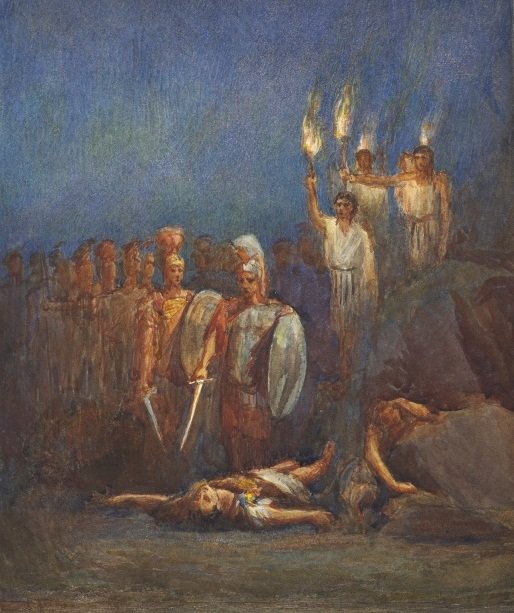Tucked away in the Shakespeare Birthplace Trust’s Rare Books strongroom is an item that has until recently been shrouded in mystery: a unique edition of Julius Caesar with an undocumented origin, purpose, and past.
The item features printed pages of Shakespeare’s text pasted onto thick watercolour paper. On every single page, the playwright’s words have been surrounded by beautiful, hand-painted illustrations of moments in the play.


The illustrations are exquisite. Figures swathed in richly-coloured fabrics are depicted standing alongside Roman architecture. Portraits of characters in the play jump out from the pages, their features carefully crafted with watercolours, inks, and chalks. Some passages of text are accompanied by storyboard-style representations of the action unfolding; others are pasted opposite dramatic images that fill an entire page. Detailed studies of armour and costume designs complete the collection of images.
Who created this masterpiece, and for what purpose?


The title page reveals that the artist responsible for producing these illustrations was named Ethel Webling, and that the item was created in 1898. Though it appears at first that the images represent an imagined world (included to assist the reader in building a picture of the places and people referred to in the text), the title page suggests otherwise: it claims to be a ‘record’ of Herbert Beerbohm Tree’s 1898 production of the play, staged at Her Majesty’s Theatre, London.

Tree is considered a significant figure in the history of Shakespearian performance, noted for his spectacular stagings of the playwright’s work during a period in which theatre was a highly elaborate, visually-focused affair. Some information has come down to us regarding Tree’s Julius Caesar: the SBT holds a black-and-white photograph of the production in performance, the Victoria & Albert Museum features a contemporary painting of Tree as Mark Antony, and a number of reviews survive in newspaper cuttings and printed texts. If accurate, Webling’s illustrations have the potential to reveal further valuable details of the production’s stage and costume design, and its actors’ facial expressions and spatial relationships.
